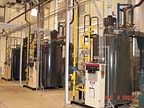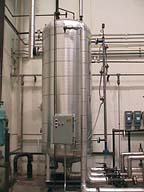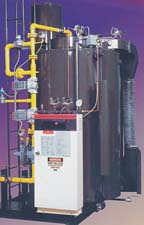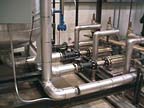A paper corrugator uses as much or more steam than a brewery, a refinery, a textile mill or a large medical center.
Steam heat is crucial for the production of high-quality corrugated board. Perfectly produced corrugated is durable, consistent, and very flat-providing a surface that is readily printable. A constant temperature must be maintained throughout the manufacturing process to achieve this desired flatness.
One Midwest corrugator with 188,000 square feet under its roof puts heavy demands on its steam boilers for processing corrugated products (the boilers are not used for heating the plant).
The maintenance superintendent, who has been there for 18 years, recalled a critical time three years earlier: "Our coiled watertube boilers were old and not reliable anymore, and parts were expensive."

Steam's Roll In the Process
The final corrugated paper product is composed of two liner papers bonded to a corrugated or fluted paper layer in the middle. The liner layers are usually heavier than the corrugated layer.The first machine in the corrugated line is called the single facer. It actually flutes the paper medium and glues one liner to it. A typical system might run a range of paper weights from 23 lbs. to 69 lbs. Paper widths are usually 70-110 in. The paper is pulled over the six to eight steam-heated cylinders of the single facer. The cylinders are typically 12-18 in. in diameter.
The cylinders heat the rolls of paper. They condition the Kraft paper as it rides over the rolls of the single facer, making it more receptive to the adhesive when the product is bonded together. Then the paper is pulled flat as it goes over steam chests-hollow blocks of steel filled with steam-that help cure the adhesive.
The weight of the paper being run determines the amount of steam being used at any given time-the heavier the paper, the greater the demand for steam. Heavier paper absorbs more heat. When light paper is run, there is less demand for steam.
The demand for steam is fairly constant; fluctuations are gradual. This steady steam demand often is only interrupted by the weekend shutdown.
The starch adhesive used to bond the paper layers is heated in large steam heated mixers that typically hold 600 gals. The glue is warmed to 105

Cascading Condensate Recovery
The corrugated industry has employed various systems to recover and reheat the hot water that is formed as steam emits its heat and condenses. Originally, the steam passing or cascading from the rollers of the single facer to the hot plate, or double facer, produced an inefficiency that was addressed by a development in the '60s.Cascade was the original system going back to the first corrugators. It was a holdover from the paper mills that had bought up the corrugators. Paper mills weren't concerned about energy loss because they were burning bark and other waste products. But, increasingly corrugators started to take a hard look at ways to save energy.
In a cascade system, steam feeds into the single facer at one point, feeds all the rolls from that point and then collects condensate from all the rolls into one vessel. Though the cascade system worked, it was more complex than a system developed in the '60s called a high-pressure return system.
This high-pressure return system used traps instead of the orifices used in the cascade system. To create the high-pressure return, a pump, such as the Cochrane-Becker, took high-temperature, high-pressure condensate from the corrugator and pumped it directly into the boiler. The boiler used a trap that knew the difference between a gas and a liquid. Air is a gas, as are the non-condensable gases that are formed in a steam system, including flash steam, i.e. the condensate that flashes back to steam. But, the trap could not tell the difference between these gases, so it would stay shut until it vented all the gases.

The Semi-Closed System
John Malinowski of M&M Services in West Chicago, IL, sells and services Miura and Clayton boiler systems for corrugators. He explained how a semi-closed system of circulation increases system efficiency: "Most corrugators have a semi-closed system, where the heat is retained in a high-pressure receiver. Either the hot well tank (also called a makeup tank or condensate tank) or deaerator feeds the semi-closed receiver tank, which is under about 80-120 lbs. of pressure. At that pressure, it stays at about 300
Refinement of the High-Pressure Return Systems
A trap that can distinguish between gases was developed in the early '80s. It contains a float that senses the condensate and a thermic element that senses temperature. Flash steam is created at a lower temperature. That temperature difference causes the trap to open and blow the gas out. The trap becomes a temperature and condensate slave. A constant draw into the trap is caused by a Venturi tube, which is also designed to vent non-condensable CO2, nitrogen and oxygen gases.One problem caused by traps that can't differentiate between gases is the speed at which air in the corrugator can be displaced by steam. When steam cools and becomes liquid condensate, there is a 1,600 to one volume change. So, when a corrugator shuts down on Friday night, all the steam that is in the corrugator condenses, producing a vacuum that pulls in air through the rotary joints and other vacuum release valves. Thus, the whole corrugator is filled with air. When it is restarted on Sunday night, the air has to be removed before the corrugator can get hot enough to run double-walled board. With the old trap system, it would take about two days, so corrugators tried not to schedule the production of double-wall corrugated until Wednesday; it took that long to get rid of all the air out of the machine. The new traps stay open and release all the air in the system so that steam can rapidly replace it. With the newer high-pressure return trap system, a plant can be up and running within an hour if they have the type of straight watertube boiler that is at full power in five to 10 minutes.
In a high-pressure return system, steam pressure for the normal American-made corrugator is about 170 lbs.-380

Boiler Technology Improves Steam Reliability
Boilers were always the source of heat for the corrugated process, but early on, firetube boilers fell out of favor because of their size and space consumption. When a coiled watertube boiler was developed, it had some advantages over the firetube boilers. The coiled watertube boilers such as Clayton's or Vapor's, took up much less space than the huge drum-like water vessels of firetube boilers. They were compact and more efficient than the firetubes, plus their design eliminated the danger of pressure vessel explosion that was ever-present with firetube boilers.Coiled watertube boilers rely on a pump that maintains constant pressure. It circulates the water through the coils.
The pump establishes water circulation in the tubes. This high-pressure circulation is critical for both steam production and for returning the condensate product back into the semi-closed receiver. It's a positive displacement pump with a constant output. For instance, a 300-hp boiler, might require a minimum of 20 gals. per minute. But the pump may pump 25 gals. a minute, with the rest being returned via the trap on the steam separator back to the semi-closed receiver.
Positive Displacement Pump Maintenance
This diaphragm hydraulic pump is subject to constant wear and tear to the seats, disks, springs and diaphragms. In the corrugated industry, the pump lasts five to 10 years, but it has to be regularly repaired, usually twice a year. This is normal maintenance. Each maintenance session costs about $1,000 to $1,500, depending on the man-hours involved. (If the boiler is hot, there are more man-hours than if it is cold.) In other words, a minimum of $2,000 to $3,000 per year.The Midwest corrugator found the pump created production problems as well as repair expenses. As a result, three years ago they decided to replace their coiled watertube boilers.
The maintenance superintendent at the Midwest corrugator recalled: "The coiled watertube boilers have their own special pump, and it's a problematic pump. It created reliability problems."
Coiled Watertube Design vs. Straight Watertube Design
Design differences between coiled watertube and straight watertube boilers are stark. For instance, the straight watertube boilers by Miura only have a few moving parts-the damper motor, blower and some valves.The corrugator's maintenance superintendent described the new boilers, saying, "We purchased and installed from M&M Services two Miura EXH250 hp high-pressure boilers (250 psi) three years ago. Miuras are a lot more reliable. You were always pumping water with the coiled watertube boilers, whereas you just draw water when you need it with the Miuras. It's a different system that seems to work better. It has a conductivity sensor that automatically blows down as the conductivity rises. You just set a point for conductivity, and it maintains it at that level."